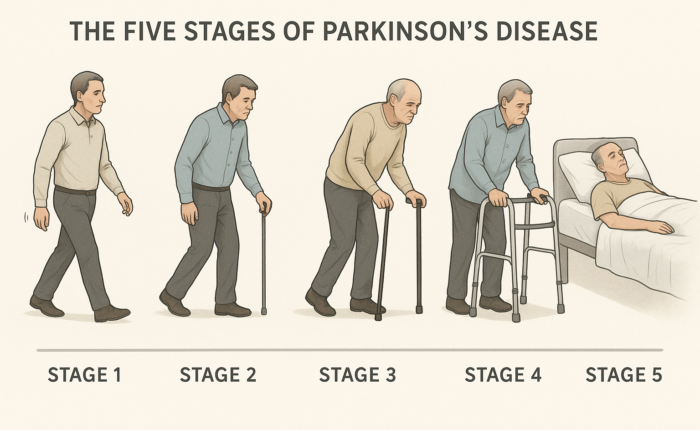The Five Stages of Parkinson’s Disease: What to Expect

Parkinson’s disease is a progressive neurological movement disorder that impacts each person differently. While some experience a slow, decades-long progression, others may face more rapid changes in symptoms. One widely used tool to understand this journey is the Hoehn and Yahr staging system, which categorizes Parkinson’s disease (PD) into five stages based primarily on the severity of motor symptoms.
Although helpful, it’s important to remember that no two people with Parkinson’s are alike. Symptom progression, responsiveness to medications, and nonmotor experiences all vary dramatically between individuals. With that in mind, let’s explore what each stage means.
Stage 1: Mild Symptoms, One Side of Body
In this early stage, the hallmark symptoms of Parkinson’s—such as tremors, bradykinesia (slowness), and stiffness—are typically limited to one side of the body. These symptoms are usually not disruptive to daily routines.
You may also notice:
- Mild difficulty with balance
- Reduced facial expression (masked face)
- Trouble swinging one arm while walking
Stage 2: Both Sides Affected, More Noticeable Symptoms
At stage 2, symptoms become bilateral—affecting both sides of the body. Tasks such as walking may become slower or less coordinated. Changes in posture, voice, and facial expressions may also be evident.
Most people at this stage can still live independently, although everyday tasks might take longer and require more effort.
Stage 3: Balance Issues Begin
Stage 3 marks the mid-point of Parkinson’s progression. Balance impairment becomes more obvious, and the risk of falling increases. Slowness in movement (bradykinesia) becomes more disabling.
Though many people in this stage are still independent, they may begin to need assistance with certain tasks like dressing or preparing meals.
Stage 4: Advanced Parkinson’s
Symptoms at this stage become significantly more limiting. People often need a walker to get around and typically require a caregiver for daily living tasks such as bathing, dressing, and cooking.
When oral medications no longer provide adequate relief, healthcare providers may recommend injectable or infused therapies to manage symptoms more effectively.
Stage 5: Most Severe Form
Stage 5 is the most advanced form of Parkinson’s. At this point:
- People may be bedridden or require a wheelchair full-time
- Rigidity and stiffness may prevent standing or walking
- Hallucinations or delusions often appear
- Full-time nursing care is usually necessary
Beyond the Stages: Other Tracking Tools
Many neurologists use the Unified Parkinson’s Disease Rating Scale (UPDRS), which looks beyond motor symptoms to include nonmotor issues, emotional well-being, and daily living experiences. This provides a more holistic view of how Parkinson’s affects each person.
Navigating Advanced Parkinson’s
When Medication Stops Working
With long-term medication use, patients may develop wearing-off effects, where treatments lose effectiveness before the next dose is due. This may occur due to:
- Dopaminergic neuron loss — The brain can’t store or release dopamine as efficiently.
- Delayed gastric emptying — Medications may take longer to absorb.
Options at this stage include infused or injectable medications to bypass these issues and ensure more consistent symptom control.
Dyskinesia: When Movement Becomes Excessive
Dyskinesia, a side effect of long-term levodopa use, can cause involuntary, fidgety movements. These may:
- Involve the face, arms, legs, or whole body
- Be triggered by emotional stress
- Occur even when motor symptoms like tremor are controlled
- Interfere with daily functioning or cause pain
Treatment strategies include:
- Adjusting levodopa dosage or timing
- Switching medications
- Adding amantadine (Gocovri) or apomorphine (Apokyn)
The Human Side of Progression
On platforms like MyParkinsonsTeam, individuals share their unique journeys:
“I was diagnosed in 2003, but things didn’t change much until 2019.”
“My PD has advanced slowly. I feel pretty good most of the time.”
Hearing from others can offer emotional support and practical advice.
Final Thoughts
Understanding the stages of Parkinson’s disease can empower you to plan proactively, from adjusting medication strategies to seeking support services. If you’re unsure where you fall on the Hoehn and Yahr or UPDRS scale, consider asking your movement disorder specialist at your next visit.
Photo-Realistic Image Prompt for DALL·E:
“Create a realistic medical illustration of the five stages of Parkinson’s disease as a horizontal timeline. Include figures at each stage showing increasing severity: from a person walking normally with mild tremor, to using a cane, then a walker, and finally in a wheelchair or bed. Background should be soft and clinical, with muted tones. Add subtle visual cues like facial expression changes and posture differences for each stage.”
Three Taglines (20 characters):
- Track Every Step Ahead
- PD Progression Visualized
- Stages of Strength
Negative Prompt:
Malformed limbs, extra limbs, distorted proportions, cartoon faces, incorrect medical gear, fantasy backgrounds
SEO keywords:
Parkinson’s stages, Hoehn and Yahr, UPDRS scale, dyskinesia treatment, advanced Parkinson’s symptoms